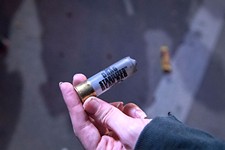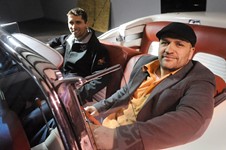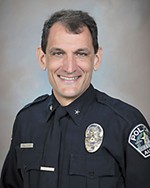'Suicide by Cop' or Preventable Tragedy?
Family and friends tried to get Herbert "Denny" Babelay the help he needed before he died
By Jordan Smith, Fri., May 31, 2013

By Sunday night, April 21, Michael Park knew his friend was in trouble. During the 10 years that he'd known 54-year-old Herbert "Denny" Babelay, Park had witnessed his friend's ongoing struggle with mental illness. Babelay was in good shape when his meds were working, when he was well-rested and staying away from alcohol. When off his meds or when the meds needed adjusting, Babelay's mind would race, he told Park, and he couldn't sleep. And so it was in late April; this time, however, neither Babelay nor his friends and family were able to get him the help they say he needed to get back on track. Instead, on April 23, Babelay died in a hail of bullets fired by four Austin Police Department officers. APD Chief Art Acevedo says officers heard the distinctive latching of a .410 shotgun being loaded and then saw the gun raised in their direction. It appeared, Acevedo told reporters, to be a case of "suicide by cop."
The four officers – all relative newcomers to the force – are currently on leave pending the outcome of both criminal and administrative inquiries into what happened just before 9pm outside the house that Babelay shared with Park and another friend in the Montopolis neighborhood of Southeast Austin. For Park and others, the shooting raises questions not only about the lack of effective mental health services in Texas, but also about how officers decide what weapon to use in a given situation. Three of the four officers who responded to the call at the home shared by Babelay and Park used their high-powered rifles, sending rounds not only into the shed where Babelay was standing, but through the walls of nearby homes.
There's no doubt that Babelay was distressed in the days before his death, Park said. In the middle of the night on April 21, Babelay was shooting a gun in the backyard, he said. The next day Babelay went to the doctor. Returning home, Babelay told Park that the doctor said he was fine but needed rest. "He needed to be hospitalized," Park said. Monday night Babelay was back in the yard, setting off Roman candles and revving up his motorcycle. On Tuesday morning, Park called Babelay's sister, and she called the police. But by the time an APD mental health officer arrived, Babelay had left, eventually ending up at the Continental Club, where he was a regular at the Tuesday "hippie hour" show with Toni Price.
While he was gone, Park and Babelay's brother, Scott Hardy, raided a small shed behind the house, where Babelay kept some of his belongings – including several firearms. "We took all the guns we could find," Park recalls. They didn't find the .410 shotgun – nor, as it happened, a .45 automatic that Park said he saw Babelay wearing in his rear waistband when he returned home that evening. At 8:19pm, Park called Hardy, and Hardy immediately called police. The goal, Park said, was to get a mental health officer over, to have Babelay hospitalized. Hardy said he was on the phone with Park trying to find out what was happening, and whether the mental health officers had arrived, when he heard gunshots ring out. "That sound still echoes in my mind and makes me physically nauseous," he wrote in an email to the Chronicle.
Indeed, before a mental health officer arrived, four other officers appeared, Park said, three of them armed with M&P15 rifles, the fourth brandishing his .40-caliber duty pistol. Babelay never fired any weapon, but police did later collect from the scene a number of .223-caliber cartridge cases from the driveway and backyard of the home, and .40-caliber casings from the backyard. Park said that he understands that the cops felt they had to take action not only to protect themselves, but also to protect him and others. Park says the last thing he heard before the gunfire was Babelay saying, "'You'd better get off my property!'" followed by "a cacophony of gunshots." But he wonders about the use of multiple high-powered rifles in a confined backyard area in a densely populated neighborhood adjacent to an elementary school. "I don't understand that at all," Park said. Indeed, the front of the shed, sitting at the end of a short driveway behind the modest home where Babelay lived, is pocked with bullet defects from low to high sprayed across its front. Bullets fired from the weapons also went through the walls of neighboring homes – some as far as a block away, YNN Austin reported.
According to APD Sgt. Duane Peed, a 21-year department veteran who supervises the APD academy's Learned Skills Unit, police cadets begin firearm training not long after entering the academy as part of their months-long academy training. Officers learn to use each of the weapons available to them – including shotguns, Tasers, and less-than-lethal options like bean-bag munitions – but are not taught when to use which weapon. Put simply, he said, "There are too many variables" that come into play to have any hard-and-fast rules. Cadets, however, train most often with a pistol, which is the weapon they'll keep on their hips. In the academy, cadets are trained to aim well and to manipulate the trigger properly before being run through "force-on-force" training scenarios where instructors place stress on cadets – time limits, other officers firing colored, soap-filled simulated ammunition at them – in order to induce stress and teach them to think well under pressure. Repeated lessons and drills of that sort are more important than trying to create rules governing weapon choice, he said. It isn't until an officer has been in the department for a year that he or she can even take a special two-day rifle training class. There are approximately 400-500 rifles in use in the department, Peed estimated, a majority attached to patrol units. Of the four officers involved in the Babelay shooting, the three that used their rifles had been with the department between one and three years; the officer who used his pistol had been commissioned for just a month.
Park said he understands that if Babelay brandished his shotgun at the officers they had to respond, but he wonders why they didn't approach more cautiously or even wait for the MH officer. Hardy said that he does not believe that his brother pointed a weapon at anyone – this was not a case of "suicide by cop," he insists – and he notes that even if he had raised his weapon, the cops' decision to close in on him was not a sound one. "[W]ith such escalated contact," Babelay, an Army veteran, "was literally and figuratively cornered and certainly felt that there was little or no escape given his current state of mind," Hardy wrote.
In fact, it was at least the third time that friends and family had sought help from police, and the third time that a MH officer arrived too late. According to APD, there are 139 officers who are paid a stipend as mental health responders. In 2012, APD received 8,216 mental-health-related calls for service; in all, APD responded to 575,802 calls for service in 2012.
In a letter to the mayor and City Council two days after the shooting, Jim Harrington, executive director of the Texas Civil Rights Project, asked that the city, via the Office of Police Monitor, appoint an "independent professional consultant on handling police mental health calls." Harrington argues that APD officers do not use best practices in dealing with mental health calls and that a failure to employ such tactics has resulted in police killings. Confrontation by armed officers with a mentally ill person is "one of the most common ways to [predict] the shooting death of the individual," he wrote, noting that Acevedo's description of the Babelay confrontation as an incidence of suicide by cop is a self-serving rationalization. Hardy firmly agrees. "[T]his horrible scenario was escalated with way too much firepower and contact," he said.
Park said that his friend was a good man and a talented carpenter who also suffered with mental illness and symptoms that waxed and waned. In the end, he said that Babelay's actions in the days leading up to the shooting may have been fatalistic, but he still struggles with whether his friend had to die violently. Hardy doesn't believe that had to happen. "I ... never thought I would be one of those people with a date that I would never forget," he wrote. "I lived in New York City during 9/11. I watched those towers fall. [That] was a bad day for many, many people. But April 23 is burnished into my soul."
Got something to say on the subject? Send a letter to the editor.











